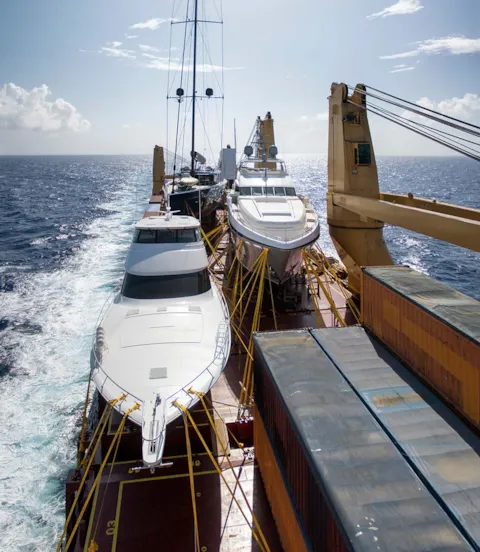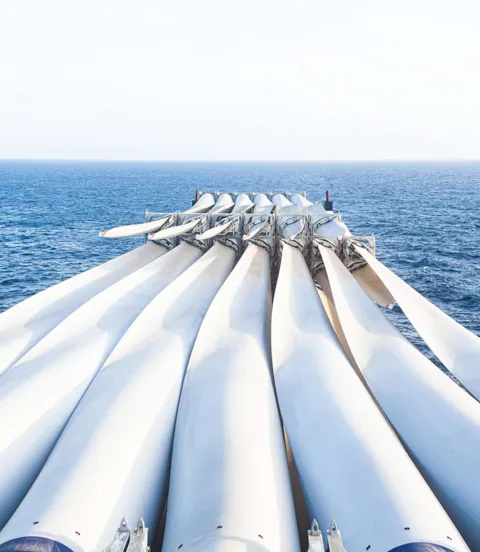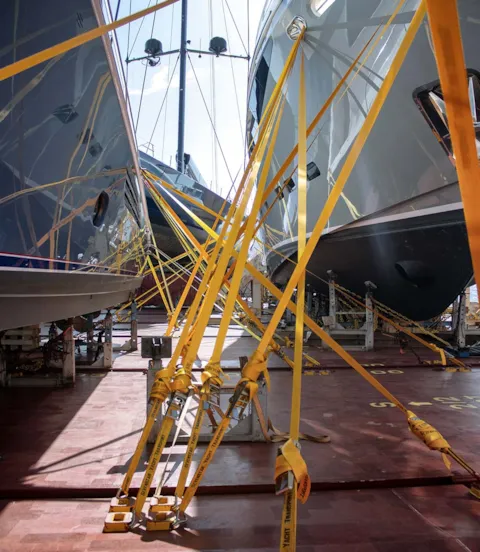Route-Specific Cargo Calculator enhances vessel’s cargo transport capabilities
Keeping transported breakbulk and project cargo safe during sea transport is the purpose of IMO’s CSS Code. But its requirements are based on the most adverse sea states and are therefore unnecessarily strict for operation in calmer sea regions. DNV has found an answer: an app that ensures cargo safety whilst it enhances stowage possibilities and flexibility as well as reduces efforts for seafastening.
A new, easy-to-use online app developed by DNV enables operators to plan the cargo stowage on board, as well as to design the seafastening of breakbulk and project cargo based on the specific route and season. Accessible on DNV’s Veracity.com portal, the “Route-Specific Cargo Calculator” calculates the accelerations the cargo will be exposed to along the given route and considers the season of the year the transport should take place. This data can then be used to plan the stowage location and bedding of cargo pieces, as well as to determine the required lashing and cargo-securing measures.
“There are tools available already for calculating route specific accelerations, but these applications tend to be very complex and are intended for engineers,” says Jan Rüde, Ship Type Expert MPV – Hull Structure & Outfitting at DNV Maritime. “We wanted to provide a solution that can be used by the shipping companies’ cargo planners without requiring major engineering expertise. A solution that delivers answers on the spot.”

The threat of wave-induced acceleration forces
Every breakbulk/ project cargo item carried on board requires individual seafastening using chains, cables, load-distribution and support frames, grillage, load spreaders, etc. As the ship moves in the waves, its cargo is exposed to acceleration forces that must be factored in when determining where and how each item should be stowed. Improperly secured cargo can break loose, endangering the crew, other cargo and the ship itself, or be lost at sea. Therefore, proper seafastening is of vital interest to all stakeholders, from the cargo owner to the shipping company, and through to the insurers.

Realistic for the North Atlantic: the CSS Code
The standard procedure for determining requirements for cargo stowage and seafastening measures for specific breakbulk/ project cargo is based on the IMO’s Code of Safe Practice for Cargo Stowage and Securing (CSS Code). However, the CSS Code assumes most adverse wind and wave conditions, as found in North Atlantic. Furthermore, as a general standard it cannot account for any ship-specific characteristics such as seakeeping behavior. This means that the values resulting from CSS Code-based seafastening calculations tend to be quite conservative, limiting the ship operator’s flexibility in stowing cargo and optimizing space utilization when operating through other, more benign sea regions. “The CSS Code calculation method produces acceleration figures that are unreasonably high for many other routes, especially during milder seasons,” says Rüde. “They lead to limitations in the stowage position of cargo, as well as excessive seafastening measures that cause unnecessary costs and time delays.”

Ship data reside in the cloud
To get more realistic values for routes exposed to less severe sea conditions, the new DNV calculator accounts for both the hull lines of the individual vessel and the wave conditions along the intended route during the relevant season.
Adrian Kahl, Project Manager for the development explains: “What really sets this app apart, is that users have to provide the ship-specific data only once for each vessel. DNV experts then run a series of hydrodynamic calculations for the ship and store the results in DNV’s cloud where they can be accessed by the app from any location and at any time. The same set of data can also be used for all sister ships of a vessel that have identical hull lines.”

Few input data, quick acceleration values
These initial calculations define for series of draught, trim and stability cases for the vessel how it will move in specific wave conditions. When planning for a transport project, all the cargo planner has to do is invoke the vessel record in the app, select the departure and destination ports and – if desired – the season, and enter four values into a simple online form: draught, trim, speed and metacentric height (GM). The system returns the applicable acceleration values at different locations of the ship in a matter of seconds.

Easy customization with DNV’s Route-Specific Cargo Calculator
The identified route between the two ports is displayed as a line on a map. To adjust the route, the user can simply include additional waypoints. Clicking the “Calculate” button will make the software display the individual sea regions along the route as geometric “tiles”. Each tile represents a set of regional wave statistics for every month of the year. If a date has been entered for the journey, the calculator will also determine how much time the ship will spend in each of these cells during the relevant season. It then generates a set of tables listing the acceleration values for each direction of acceleration (vertical, lateral or longitudinal) and for several sections of the ship, from aft to bow and from top to bottom.
The output in the familiar CSS Code format reflects both the route- and season-specific acceleration for the planned voyage as well as the standard acceleration values according to the CSS Code for reference.

Flexible stowage options and a reporting feature
For greater flexibility in choosing the stowage location on board, users can optionally enter the cargo item’s centre of gravity at the intended stowage position on the ship to obtain the precise acceleration values for that point. What is more, a maximum permissible acceleration value at a certain point can be defined, e.g. to protect especially sensitive project cargo for which the manufacturer has specified a maximum load. The app will then return the maximum wave height for the journey which must not be exceeded.
“Cargo owners want optimum protection for their cargo, so any deviation from the strict CSS Code must be justified by the shipping company,” explains Rüde. “The Route Specific Cargo Stowage app provides a printable reporting feature detailing the seafastening acceleration calculations for approval by the cargo owner. The physics behind the calculation method is described in the report which bears the DNV logo – key factors to ensure credibility and acceptability.”

Operational guidance for safeguarding cargo and vessel
As for the CSS code, the app's results for individual routes and seasons are based on statistical sea state data. To assist the ship's crew in avoiding the unlikely event that the vessel encounters sea conditions that endanger the cargo, the app and report provide information on boundary conditions for the operation. Sea states that may provoke accelerations above the predicted design acceleration applied for the cargo securing, when entered or remained in too long, are indicated in the wave scatter table for the selected route and season. With the help of weather forecasts, this enables the crew to operate the ship with high level of safety.

Minimizing fuel consumption, emissions and costs per tonne
Once the ship data have been uploaded, the simplicity of the app makes it easy to try out various cargo placement options in theory and recalculate the acceleration values on the fly. As a consequence, the available space on and below deck can be utilized more efficiently to maximize the income from freight, minimize fuel consumption, carbon emissions and the costs per tonne of cargo carried.

Up to $150,000 saved per ship per year
To verify the cost-saving benefits of the app, DNV analysed three sample voyages together with a customer using data from three different vessels and for selected cargo items. In the best-case scenario, the acceleration values on the chosen route were nearly cut in half compared to the CSS Code calculation. “Depending on the given conditions, shipping companies could save up to $10,000 per trip or more, and between $100,000 and $150,000 per vessel per year for seafastening,” reports Rüde. “And this figure does not even include the added benefit of being able to carry additional payload by making better use of the available cargo space on board. The results this app delivers speak for themselves.”
Adrian Kahl
Principal Engineer Structures
Jan Rüde
Ship Type Expert MPV
- Shutterstock / Kyrylo Chervony
- Shutterstock / Iam_Anuphone
- Shutterstock / ZHMURCHAK
- DNV